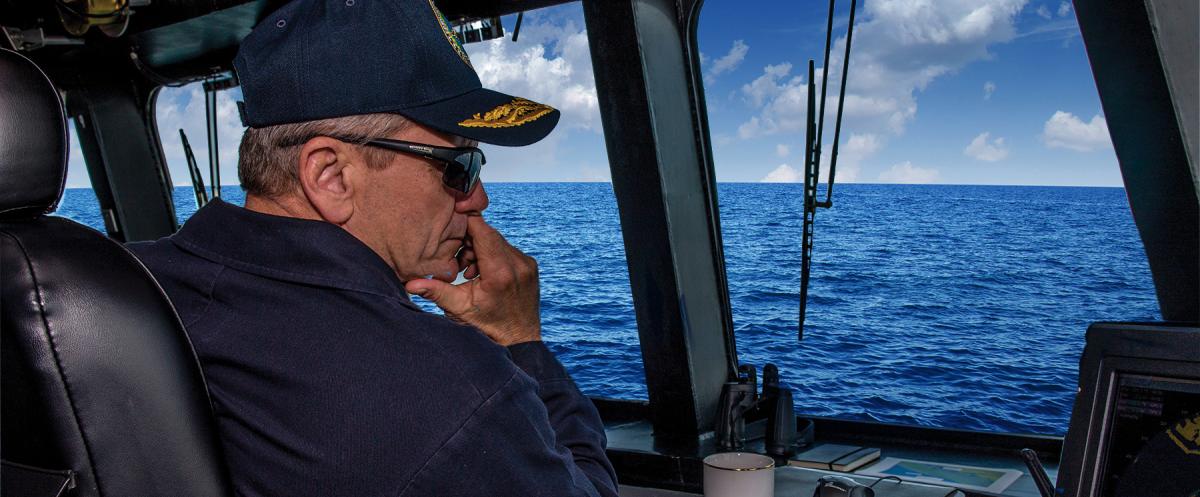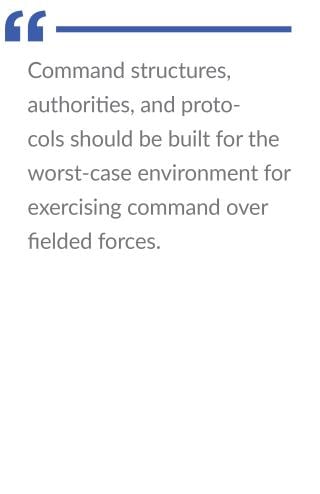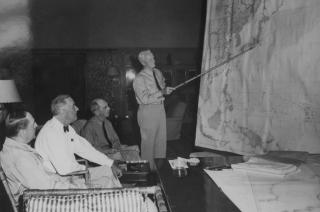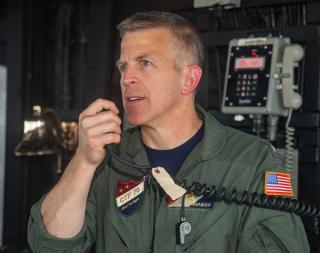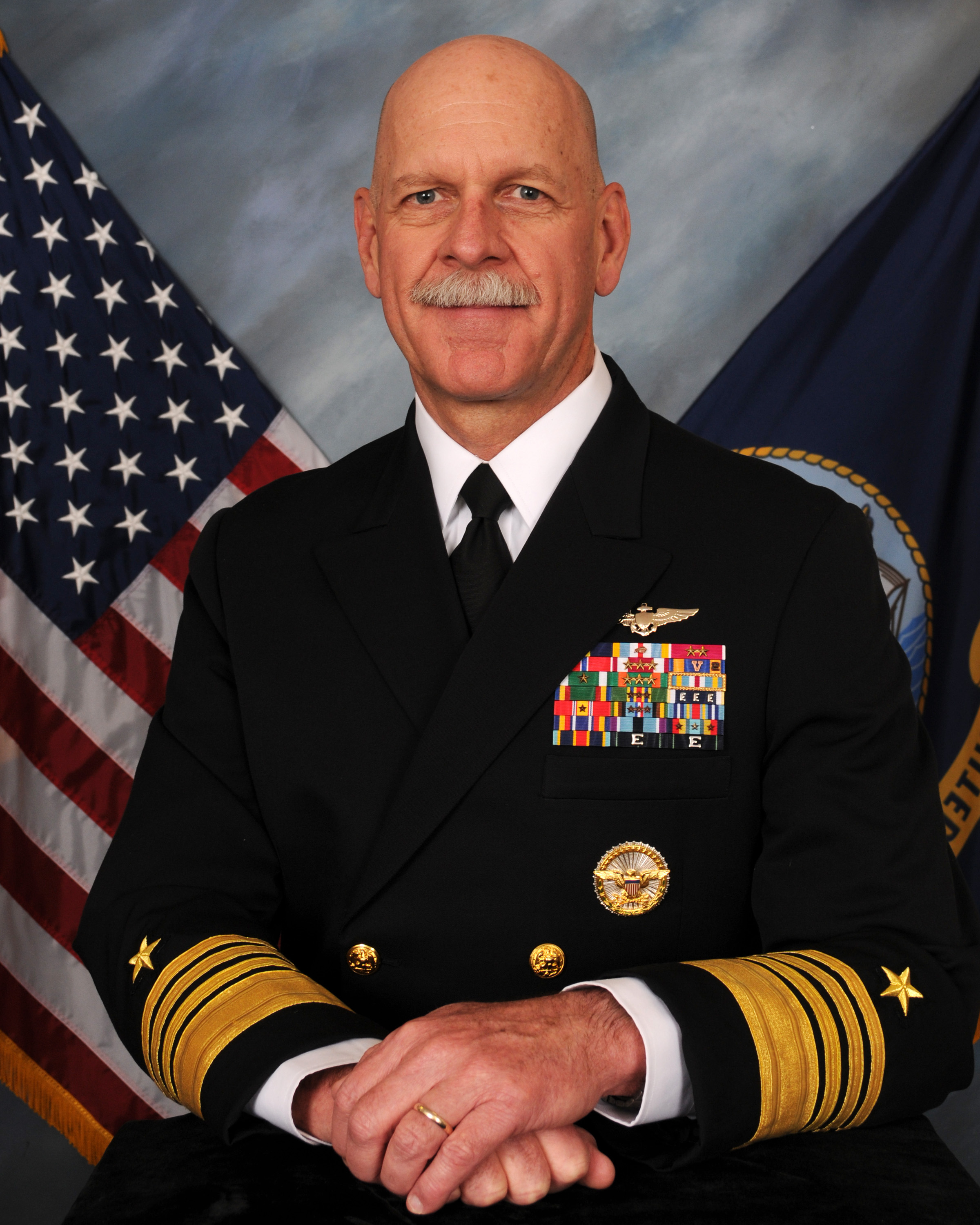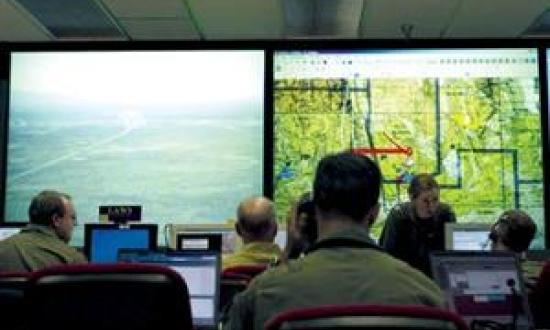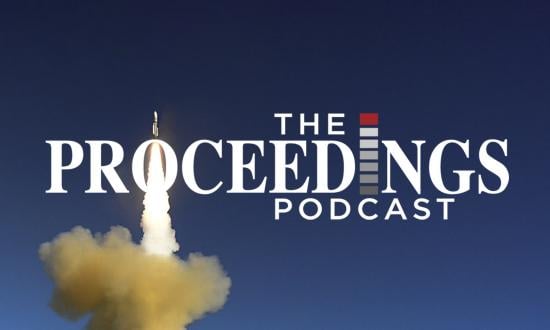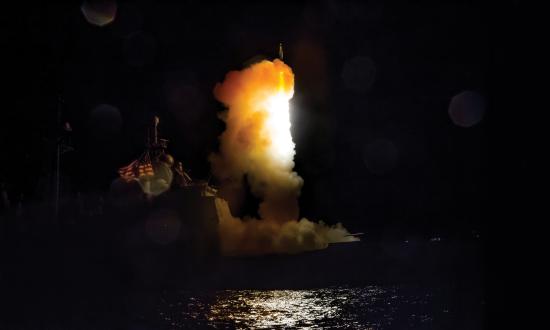Analyzing command and control (C2)—whether in an academic environment, a wargame or exercise debrief, or through a historical lens—can be an interesting but often sterile endeavor. Which senior leader made what decision based on what information available at which time? Which side put the right leaders in command with the proper control mechanisms and the authorities to act to gain decision advantage over the adversary? These are weighty but often lofty discussions.
There is nothing lofty and everything weighty about command and control in the 2026 scenario. It will be visceral and pressurized, with constant life-and-death decisions. As the scenario states, the stakes “are enormous—much greater than at any time since the Cold War or even World War II—and carry extraordinary implications. . . . ‘Business as usual’ is not viable.” Commanders at all levels will have to make the hardest decisions of their lives, often with limited time to think and with thousands of lives on the line.
What follows is a discussion of C2 based on years of study and experience in exercises and wargames focused on the western Pacific. I cannot pretend to have lived through—never mind led through—a war of this intensity. But U.S. and allied commanders must stretch their imaginations now to inform C2 relationships before such a scenario ever becomes a reality.
Initial Thoughts
It is important to explain command and control and its application, structure, execution, and management. The military mind tends to align things in vertical priorities, authorities, and responsibilities, so breaking C2 into a vertical, hierarchical context is the norm. That structuring takes the form of echelons of commands and formations and phases of competition and war.
The military does not do well with horizontal constraints and variables other than, perhaps, time. Even regarding time, services and commands focus on the near term—what needs to be done today, inclined toward crisis planning and crisis response rehearsals. When a longer view is taken, too often it does not inform near-term planning and actions. It expresses a desired end-state rather than a horizon for a long-term sequence of events; it remains, in other words, a variable that affects operational and tactical concerns, not strategic ones. Or, at the very least, it does not connect the operational and tactical considerations closely and sequentially with the strategic ones.
Increasing a commander’s planning and action horizon is critical to moving beyond reactive actions derived from direct, objective observations of enemy activity. For a commander and his or her assigned forces to succeed, they must anticipate enemy actions, maneuvering their forces to positions of advantage in space, time, and configuration. There are tools to achieve this ideal. Cycles of planning, assessments, and action are intended to drive the velocity of war to one’s advantage. They are designed to meld the science of objective planning with the art of subjective alternatives in a structured, repeatable process. Commanders and staffs train to use these tools but often fail to apply them in execution. Enemy actions and own-force friction cause timelines for action to collapse; planning timelines follow; and decision timelines become product-based rather than process-based. Enemy effects take root in U.S. commanders’ processes.
Leadership is a critical element of command and control, but talking about leadership is insufficient without discussing its relationship to management. When an operation is going smoothly and according to plan, C2 activities are best described as “managing the plan.” When an operation does not go smoothly, however, or when the plan is flawed or planning assumptions are proven to be false, those who would have managed the plan’s execution must now lead to adjust it—changing or even abandoning the plan based on emergent realities. The overall mission may remain unchanged and its functions consistent, but time constraints will force changes, which are driven by the leaders’ experience and subjective analysis.
Command and control is not a unified concept. Command is related to, but distinctly different from, control. They are characterized as a single construct—C2—but this can cause confusion, even more so when they are combined with “communications” and “computers” in the “C4” construct. In 2002, then Seventh Fleet Commander Vice Admiral Robert Willard defined the terms this way: “Command is the doctrinal assignment of authority. Possessing a measure of command is a prerequisite to exerting control. Control is defined as guiding the operation.” He noted:
The acquisition of and training on command and control (C2) tools—computers, radios, and software—became confused with the requirement for continuous training in the operational art of and methods for effective control of forces. [Emphasis added.]1
For both command and control, leader/manager authorities should be delegated to the maximum extent possible. Decision advantage is often thought of as something technology can deliver; this is a core tenet of Project Overmatch, but technological solutions will have little effect if authorities remain centralized with high-level commanders or inside individual staffs.2
Delegating authorities to lower levels increases the velocity of effects in the operational plan. It reduces the adversary’s opportunity to degrade control of forces by interdicting communications.
Reasons not to delegate authority can include subordinate commanders or commands not being trained appropriately, limited or nonexistent ability to communicate action and intent, and a lack of resources to act on delegated authorities. Solutions to these challenges exist, but they are more easily adopted before a fight. Waiting until a conflict has begun will increase the fog and uncertainty. But sometimes, plans must be improvised after the shooting starts.
A War for More Than Regional Hegemony
The War of 2026 scenario describes a struggle for regional hegemony and Taiwan, with implications for leadership of the world order. The “why,” therefore, is to defeat China’s ability to replace or displace the current international rules-based order through force and coercion. As the fighting begins, the lead national security functions must shift from the State Department to the Department of Defense. The application of military planning and effects that would have been ongoing will take priority, but they will not replace discourse, dialogue, and diplomacy.
Centers of gravity assessment and determination are critical to formulating relevant command, control, and rules of engagement. An ongoing risk-to-mission assessment must determine when there are more impediments to success than enablers. This assessment guides policy and rules of engagement (ROE) decisions that, when timely and informed, can empower friendly objectives.
A context for determining the scenario centers of gravity is found in the following statements. The U.S. and allied strategic goals are to (1) defend Taiwan by ensuring; (2) Taiwan remains autonomous; (3) China is defeated militarily; and (4) China is isolated politically and economically.
The first objective (defending Taiwan) is an outcome of achieving the second and third objectives (Taiwan remains autonomous and China is militarily defeated). The second and third objectives should be assigned to DoD as the supported authority. The fourth should be retained by the State Department as the supported authority.
Objective two should be clarified in the context of China’s stated military operation “to restore the integrity of Greater China.” This People’s Liberation Army (PLA) operation to reunify Taiwan with China is broadly referred to as the Joint Island Landing Campaign (JILC).3 Defeating this campaign is a more appropriate military mission than defeating the PLA. DoD would assign this clarified objective (mission) to U.S. Indo-Pacific Command (Indo-PaCom).
C2
Command is the structure operational commanders use to exercise their authorities to pursue assigned missions. Higher authority assigns and delegates missions to subordinates. The functions that enable mission success include: movement, maneuver, intelligence, fires, sustainment, and protection. Tasks within the functions are actions that create the necessary effects to achieve the assigned mission.
Command is executed through control mechanisms. Broadly those mechanisms are provided by the man, train, and equip functions of the service chiefs and endorsed by the Secretary of Defense through the Planning, Programming, Budgeting, and Execution (PPBE) process. They are codified in law through the National Defense Authorization Act (NDAA).
Scenario Command Considerations
Command structures, authorities, and protocols should be built for the worst-case environment for exercising command over fielded forces. The command environment in this scenario will be the most contested since World War II. Each side takes an opposing philosophical approach to command, one embracing decentralization as a core strength, the other treating it as a core weakness. It is incumbent that U.S. command structures are built on a decentralized foundation of mission command.
Mission Command / Commander’s Intent
According to the 2020 Joint Staff paper “Mission Command,” the subject is philosophically focused on the art of war and is defined as “the conduct of military operations through decentralized execution based on mission-type orders.” The paper goes on to say mission command “exploits the human elements of trust, force of will, intuition, judgement, and creativity, exercised through disciplined initiative.”4 This is why delegating authority must be a commander’s routine practice. If not practiced in times of stability and clarity, it will not happen in the chaos and fog of war.
The underpinning document that provides order and clarity to mission command is commander’s intent. Mission command is a concept, and commander’s intent provides its structure. Often described as what constitutes success for the operation, commander’s intent highlights the purpose, key tasks, and conditions that define the end-state. This view, however, lacks an essential understanding of the different time horizons required to deal with peer competition, crisis, and conflict. Commander’s intent should be conditions-based on a horizon of interest relevant to the engaged forces. These changing conditions extend from the strategic to tactical levels, include risk/advantage to force and mission, and cross all functions of warfare, including movement, maneuver, intelligence, fires, sustainment, and protection. For the past 30 years, U.S. commanders have had the luxury of time continuums that are too long for this scenario at the tactical level.
Success requires breaking down tactical operations into shorter time frames, aligning the focus of engaged forces to the battle conditions they will experience. At the operational and strategic levels, where the echelon I and II commanders and staffs function, longer time horizons will be the norm. The days of Operations Iraqi Freedom (OIF) and Enduring Freedom (OEF), where all echelons often functioned at the tactical edge, are informative but not instructive. Those who do not command at the echelon they are assigned will not succeed.
Mission is an end-state—in this case defeating the Chinese JILC. Commander’s intent, however, is conditions-based. Initially, it might be “Create the conditions to deter the PLA’s campaign to take Taiwan.” If the PLA is not deterred, commander’s intent must change. When to transmit the updated intent depends on available communications.
For these reasons, commander’s intent should be part of a running assessment. It should be a living document, changed and updated as battle conditions change and reissued as the communications allow. It should be concise for ease of transmission, and unambiguous to subordinate commands that may not have the benefit of knowing the conditions that drove the changes.
Command Relationships
Unique and shared command responsibilities will have to be negotiated with the Secretary of Defense and the Chairman of the Joint Chiefs across combatant and functional commanders. With global authorities and responsibilities, U.S. Strategic Command, Space Command, Special Operations Command, Transportation Command, and Cyber Command all will be operating in the theater. Adjacent combatant commands—Central Command, Africa Command, European Command, Southern Command, and Northern Command—all have coordinating equities. With every combatant and functional command engaged, command authorities must be as simple as possible.
Because the outcomes of this conflict are critical, combatant, operational, and tactical control of forces must be the rule. Joint Publication 1 notes that all three have unique attributes, but all have a common critical element—assigned authority to organize and employ commands and forces as the commander considers necessary to accomplish assigned missions.5 These authorities, centralized in theater commanders, are critical to sustaining the clarity, accountability, and responsibility for success of the missions assigned to counter the PLA. Specifically, authorities include those to “plan for, deploy, direct, control, and coordinate the actions of subordinate forces.”6 Power delegated is power applied.
Supported/Supporting
The supported/supporting command relationship should be avoided. It is applied when there are more missions than forces assigned can support and more tasks than resources available. If this was not the case, then operational or tactical control authorities would be applied. These authorities are “by design, a somewhat vague but very flexible arrangement.”7 Joint Publication-1 further states: “When a supporting commander cannot fulfill the needs of the supported commander, the establishing authority will be notified by either the supported or a supporting commander. The establishing authority is responsible for determining a solution.”8 In this scenario, this “vague but very flexible arrangement” will increase the workload of overtasked senior commanders.
If operational tempo is low to moderate, supporting/supported command authorities work well to allow a supporting commander to serve under resourced commanders. As operational tempo increases, however, the available bandwidth of senior commanders and their staffs decreases, reducing their ability to adjudicate supporting or supported commanders’ conflicting support. As a result, these adjudication priorities are determined by default rather than design, with subordinate commanders making decisions without necessary experience, intelligence, operational insight, or authority. Without the preponderance of force and internal logistics lines, supported/supporting command relationships are high risk.
Joint Command Structure
Commander, U.S. Indo-Pacific Command, should be authorized as the joint force commander (JFC), responsible for mission achievement, but no single service can win this fight. Missions must be centralized through multiservice joint command structures. Functions must be joint, drawing on capability distributed across all services. Tasks must be assigned to joint formations based on the highest probability of success with the least risk to force/mission and lowest cost in resources required.
The JFC would establish subordinate command elements with assigned subordinate missions in specific areas of operations. Those missions would inform the establishment of joint operations areas providing geographic boundaries of assigned missions, authorities, responsibilities, functions, tasks, and risks. One of these command elements would be the commander, joint task force (CJTF), subordinate to the JFC.
CJTFs have the authority to establish and assign missions and authorities to subordinate task force (TF) commanders. These can be domain-based, such as joint force maritime component commander, joint force land component commander, etc. In this scenario, the CJTF should establish them based on mission or function. An example of a mission-based TF would be to establish freedom of maneuver to conduct fires in support of CJTF mission objectives. A function-based TF would be ordered to provide logistical support to other TFs.
Multinational Operations and Interagency Coordination
Another advantage of joint command concepts is that their design accommodates multinational operations and interagency coordination.9 Applied command concepts are most likely to succeed if practiced, exercised, and tested on a regular basis. There is deterrent value in these actions as well, demonstrating will, commitment, capability, and capacity. This is true with respect to operating with key allies as well, but too often allies are not assumed to be part of the command structure. Decisions about command constructs are often deferred—to be determined as the conflict develops. This is dangerous. U.S. and allied forces in the Indo-Pacific should commit to a structure now. Test and exercise it with an eye to increasing confidence in it. Apply an ongoing combined assessment of the structure with recommended changes and improvements based on a rigorous assessment of what works and what does not.
Success in this scenario requires exploring options before such a war breaks out to develop the highest level of integration possible between the United States and Taiwan. Cooperation with Taiwan may be the best that can be achieved, but this is just the first for four critical levels of integration. Cooperative organizations remain separate, conducting independent operations but cooperating to be aware of the timing, tempo, and intention of each other’s independent operations.
Coordination is the next level of integration. Coordinated organizations may share staff. Even liaison staff are of great value. The goal is to adjust the timing, tempo, and intention of operations to ensure conflicts are minimized and to optimize independent operations when possible.
The next higher level is collaboration. While command functions are not integrated in the U.S. joint context, U.S. and allied command staffs could be collocated to collaborate during operational planning and execution.
The ideal state is combined operations with full staff integration. On a multinational level, NATO is a good example, while Combined Forces Command Korea demonstrates bilateral integration.
Decentralized Control and Execution
These command structures—formed according to the tenets of mission, function, and task—avoid the temptation of senior commanders to place priority or preeminence on specific capabilities to be used by subordinate commanders. It requires seniors to give subordinates the mission, commander’s intent, and broad mission orders, reinforced with clear operational control and tactical control authorities over forces assigned.
Delegating the latitude to plan how to accomplish missions with the resources assigned will ensure unity of command and effort and optimize resources. No one warfare area or capability should be the primary focus of any commander.
Rules of Engagement
Rules of engagement are defined as “directives issued by competent military authority that delineate the circumstances and limitations under which United States forces will initiate and/or continue combat engagement with other forces encountered.”10 The key words are circumstances and limitations. ROE can diminish the efficiency and effectiveness of military operations. When this occurs, it is incumbent on military commanders to inform civilian leaders of the effects on risk to mission and force. Discussions of ROE ensure all the implications—both intended and otherwise—are fully understood. This requirement underscores the importance of ROE so that law-of-war (justice in war) principles such as military necessity, discrimination, and proportionality are fully adhered to.11 When a commander assesses that the ROE provides insufficient latitude for success, he or she must inform civilian leaders—who determine the rules—of the risk.
Complying with ROE also emphasizes the centrality of civil authority over military operations. Core to ROE is ensuring all military operations are fully compliant with international law; and guided by restraints (must not do) and constraints (must do) of U.S. civil government authorities. Multinational operations require a clear understanding of the application and implications of every participating nation’s ROE caveats.
Control Considerations
With a clear delineation between command and control, control considerations become more distinct—as Admiral Willard put it, the ability to guide combat operations and forces. This is the amalgamation of software, hardware, and people to deploy, employ, and optimize C5ISR. These are the enabling capabilities and tools of command.
In OEF and OIF, the control environment was much less contested than the one envisioned in this scenario. The implications of control mechanisms in this scenario are just as critical as the command structures. Control capabilities and tools should be built to support the worst-case environment for exercising command over fielded forces in denied areas. Project Overmatch is an example of an effort designed to provide hardened battle networks to operate in contested environments.
Understanding PLA capabilities to interdict U.S. and allied control mechanisms allows hardware, software, and training to support best-case practices as well as worst-case fallback protocols. Systems, plans, and training must account for the graceful degradation of control, with the attendant implications to command.
To best hedge against the enemy’s capability to interdict control mechanisms, commanders must habitually delegate authority, practice mission command, and frequently update commander’s intent. Cross- or in-echelon command structures and practices must be ready to take over when down- or up-echelon command structures are no longer available.
Summary
Joint power, capacity, and capabilities must be centralized under joint command authorities. Mission, function, and task authorities must be assigned with the clarity and certainty provided by operational and tactical control constructs. Devolving to supported/supporting constructs is a leading indicator of insufficient resources for the missions assigned. Mission command, with its supporting commander’s intent, ensures unity of command and effort when control mechanisms are interdicted or overwhelmed. Control is separate and distinct but related to command. And judicious delegation of authority helps sustain the velocity of action, protecting decision superiority.
A war such as the one in this scenario would be demanding, lethal, and risk-filled. To prevail, commanders must remember these historical tenets of command and control, applying them with the knowledge that war complicates everything. As Albert Einstein might have advised, C2 must be as simple as possible, and no simpler.
1. VADM Robert F. Willard, USN, “Rediscover the Art of Command and Control,” U.S. Naval Institute Proceedings 128, no. 10 (October 2002), 52.
2. Mallory Shelbourne, “Navy’s ‘Project Overmatch’ Structure Aims to Accelerate Creating Naval Battle Network,” USNI News, 29 October 2020.
3. Cristina L. Garafola, “China Maritime Report No. 19: The PLA Airborne Corps in a Joint Island Landing Campaign,” China Maritime Studies Institute, 5.
4. Joint Chiefs of Staff, Insights and Best Practices Focus Paper: Mission Command, 2nd edition (January 2020), 1.
5. Joint Chiefs of Staff, Joint Publication 1: Doctrine for the Armed Forces of the United States, 25 March 2013 Incorporating Ch. 1, 12 July 2017, V-6, 7.
6. Joint Chiefs of Staff, Joint Publication 1: Doctrine for the Armed Forces of the United States, V-7, 3. c. (7).
7. Joint Chiefs of Staff, Joint Publication 1: Doctrine for the Armed Forces of the United States, V-8, 5. a.
8. Joint Chiefs of Staff, Joint Publication 1: Doctrine for the Armed Forces of the United States, V-8, 5. a.
9. Joint Chiefs of Staff, Joint Publication 1: Doctrine for the Armed Forces of the United States, II-21, II-13.
10. Joint Chiefs of Staff, JP 1-04: Legal Support to Military Operations, 2 August 2016, GL-3
11. Joint Chiefs of Staff, JP 1-04: Legal Support to Military Operations, 2 August 2016, II-2.



